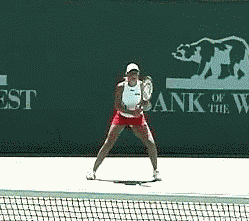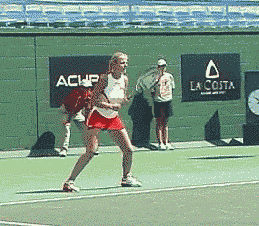|
TennisOne Lessons
First Things First - The Educated Foot By Jim Mclennan
Joe Montana fading back into the pocket and setting up to pass downfield, David Wells pitching from the stretch, Barry Bonds waiting on the pitch - in each instance the "weight" is on the back foot. This is not to say they throw or swing from their back foot, nor is it to say they step entirely onto their front foot, but rather, to begin the swing, or the throw, initially the "weight" is "waiting" on the back foot. On court, you read the opponent's shot coming to your forehand. You turn quickly and easily, your posture is good, your vision squarely and dead level on the incoming ball. Your hands are quiet, at this moment and your weight should be entirely on your right foot, which for the purposes of this article is the back foot (right-handed players with reference to the net). In the Tom Stow lessons, I would tap the left toe lightly to demonstrate my balance on the right foot. If there is no subsequent movement required I can begin the stroke from this position with a subtle step onto the left foot, which actually centers my weight. Now both legs and hips can drive the torso, shoulders, arm, and racquet into the ball (We will get to the use of both legs in this "dual" leg drive, but that is a bit later). For the backhand the feeling is the same, but the feet are reversed. In this instance, my turn, with good posture, centered vision, and quiet hands places all the weight on the left foot, and again I can demonstrate and or evaluate my balance by lightly tapping my right toe.
On the serve, much like the turn on the forehand, the initial movement places the weight again on the back foot. And for those of you who may be skeptical here, note that indeed the pitcher places his right foot on the pitching rubber in order to step with his left foot to deliver the pitch. The turn is less pronounced when volleying at the net, but again on the forehand the turn places the weight more on the right foot, and on the backhand the turn places more of the weight on the left foot. Moving in Twos Borrowing a page from Jim Irwin's teaching book (Jim is an old friend, former teaching assistant to Tom Stow, and a man that faithfully reteaches the Stow system in the Northern California Bay Area), after the turn move in two's to the ball. That is, with the weight on the right foot, move in two-step sequences to the ball so as to always arrive on the back foot. Turn onto the right foot, then left-right, left-right and you arrive with your weight back (not forward) and with the "weight" "waiting" on the back foot you can then initiate the swing from the ground up. Moving in twos to the backhand, turn shifting the weight to the left foot, then step right-left right-left and again you arrive on the back foot waiting to unleash a backhand drive. Another of my mentors, the late and great Fred Earle, called the back foot the "educated" foot. That is, he showed players that when moving to the ball, the final positioning step should be made with the back foot, so the step and swing would be more about rhythm. When the final positioning step is made (unfortunately quite common) with the front foot, there is less rhythm and use of the body in the swing.
Turn, posture, vision, quiet hands, and finish your positioning with your weight on the back foot. That is all there is to it. The trick is in the faithful and repeated practice, remembering that practice only makes perfect when practicing perfectly. Note: The above material describes a "weight shift" situation (passing footballs, pitching hard balls, swinging baseball bats), which is not exactly like the open stance, a groundstroke used by many if not all of today's professionals. In the open stance model, the player either turns into the swing with the weight entirely centered and remaining on the back foot, or the step places the weight evenly centered between both feet. In this model, the rotational leverage is more important than the shift of weight. They are simply different models, neither is right or wrong, and in many instances a hybrid of the two is what many players unknowingly use. The Trigger Now to the "trigger" that is, you are on your back foot, waiting (and weighting) on the ball. Again your reference point here is your ability to lightly and quickly tap the toe of the front foot. When you can do that easily, with out repositioning, it confirms your balance on the other (in this case back) foot. So the pitcher, the batter, and the tennis player "triggers" or initiates the stroke from the ground. That is the throw, swing, or tennis stroke begins with a shift from the back foot to the front foot. Tom Stow called it "Step..And..Swing," where the cadence of his phrase was step and swing the words spoken quickly together to indicate not a long pause between the step and swing but rather a quick rhythmic step-and-swing.
Watch the pitcher on this one - a flowing motion of all parts of the body begins with the shift. The pitcher takes a long stride, partly to get as close to the batter as possible. On the other hand the batter takes a short stride, seemingly centering his weight on both feet before the swing. On this, John White, in an excellent book entitled Batting Basics, where White compares the batting swing to the physics of a spinning gyroscope, notes that for fullest turning effect, the batter must be equally centered on both legs to get the maximum from a dual leg drive. The tennis example is a little trickier. Let me try. If your intention is to employ the rebound velocity of the ball, or your intention is to follow your shot to the net, then the step moves the weight entirely onto the front foot and the swing follows. This is a weight shift model with less emphasis on rotation of the body. If your intention is to rotate quickly into the hit, if you prefer open stance strokes, if your swings are less rebound oriented and more power oriented, then in this case the stride is shorter and the dual leg drive is employed. On court, my suggestion is to "hold your finish" for a moment on the follow-through. You can do this on a forehand, a backhand, or even a serve. And when "holding," note whether you can now tap the back toe (with out repositioning) while remaining balanced on the front foot. This toe tapping is not pertinent during a point or even in a rally, but when practicing for practice sake, holding and tapping will clearly identify the quality of your weight shift. Your comments are welcome. Let us know what you think about
Jim McLennan's article by emailing
us here at TennisOne.
|
|||||||||||




